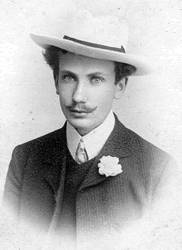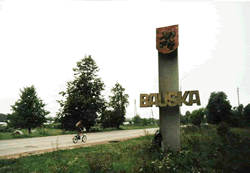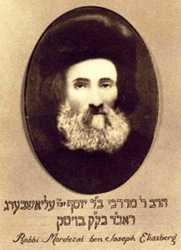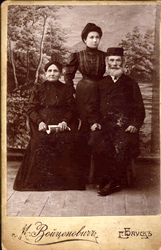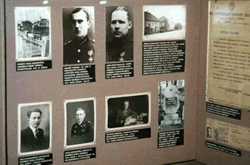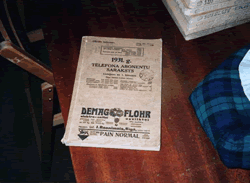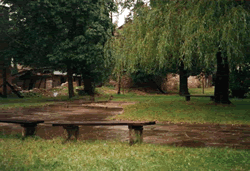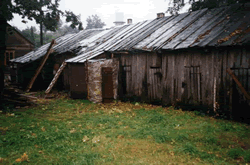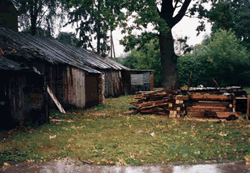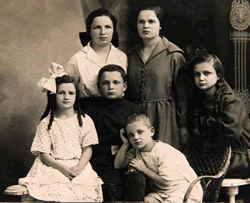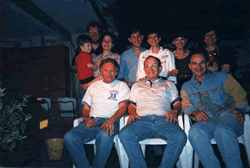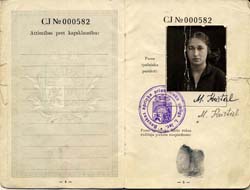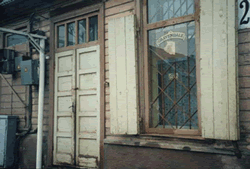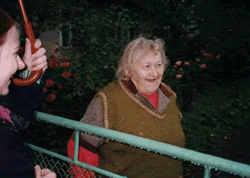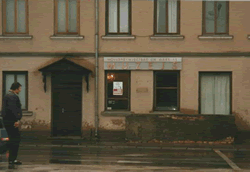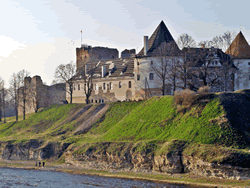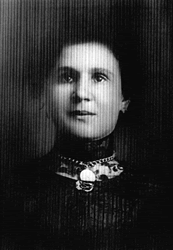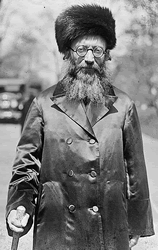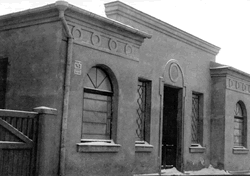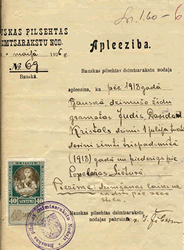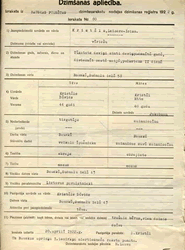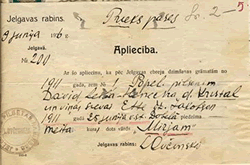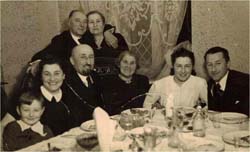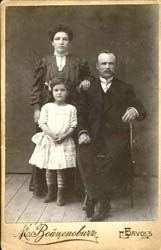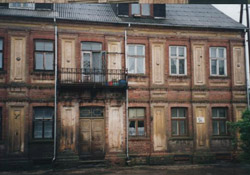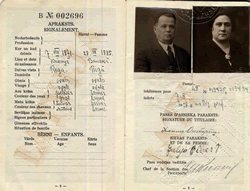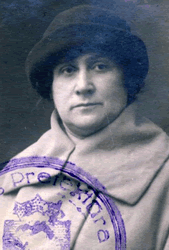BAUSKA: Courland (Zemgale ) now in Latvia
Alternate names: Bauska [Latv], Bausk [Rus], Bauske [Ger], Boisk [Yid], Bausk [Lith], Bowsk [Pol], Bosko.
56°24' N, 24°11' E , 38 miles S of R?ga, 25 miles SE of Jelgava, 20 km from the Lithuanian border. Jewish population: 3,631 (1881), 604 (1920). The town in Bauska municipality in the Zemgale region of southern Latvia is situated at the confluence of the rivers M?sa and M?mele where they form the Lielupe River.
http://www.iajgsjewishcemeteryproject.org/latvia/bauska.html
Created by Edward Janes edwardjanes@gmail.com and Eilat Gordin Levitan
|
#bau-1: Michel Jacobsohn--my grandfather c 1900, He moved to Namibia and S Africa before moving to Philadelphia in 1907. Ed Janes |
#bau-2: My 2nd cousin Les visited Bauska and they took these pictures of our family address. also a very small Jewish "museum". there was one Jew alive in Bauska when they visited in 1990. Ed Janes |
#bau-3: Rabbi Mordecai ben Joseph Eliasberg, rabbi of Bauska between 1861 – 1889. Studied in Volozhin yeshiva. One of the pioneers of Religious Zionism. Rabbi Mordechai Eliashberg died in 1889 in Bauska. |
|
#bau-4: My g-grandparents Leizer and Pere Chaje Brener Jacobson circa 1890 in Bauska. The woman is Ette Jacobsohn. Ed Janes |
#bau-5: My 2nd cousin Les visited Bauska and they took these pictures of our family address. also a very small Jewish "museum". there was one Jew alive in Bauska when they visited in 1990. Ed Janes |
#bau-6: My 2nd cousin Les visited Bauska and they took these pictures of our family address. also a very small Jewish "museum". there was one Jew alive in Bauska when they visited in 1990. Ed Janes |
#bau-7: My 2nd cousin Les visited Bauska and they took these pictures of our family address. also a very small Jewish "museum". there was one Jew alive in Bauska when they visited in 1990. Ed Janes |
#bau-8: My 2nd cousin Les visited Bauska and they took these pictures of our family address. also a very small Jewish "museum". there was one Jew alive in Bauska when they visited in 1990. Ed Janes |
#bau-9: My 2nd cousin Les visited Bauska and they took these pictures of our family address. also a very small Jewish "museum". there was one Jew alive in Bauska when they visited in 1990. Ed Janes |
#bau-10: My 2nd cousin Les visited Bauska and they took these pictures of our family address. also a very small Jewish "museum". there was one Jew alive in Bauska when they visited in 1990. Ed Janes |
#bau-11: My 2nd cousin Les visited Bauska and they took these pictures of our family address. also a very small Jewish "museum". there was one Jew alive in Bauska when they visited in 1990. Ed Janes |
#bau-12: My 2nd cousin Les visited Bauska and they took these pictures of our family address. also a very small Jewish "museum". there was one Jew alive in Bauska when they visited in 1990. Ed Janes |
#bau-13: |
#bau-14: My 2nd cousin Les visited Bauska and they took these pictures of our family address. also a very small Jewish "museum". there was one Jew alive in Bauska when they visited in 1990. Ed Janes |
#bau-15: My 2nd cousin Les visited Bauska and they took these pictures of our family address. also a very small Jewish "museum". there was one Jew alive in Bauska when they visited in 1990. Ed Janes |
#bau-16: My 2nd cousin Les visited Bauska and they took these pictures of our family address. also a very small Jewish "museum". there was one Jew alive in Bauska when they visited in 1990. Ed Janes |
#bau-17: Bauska's Castle |
#bau-18: Avrahan Trusfus. He is a distant relative from Bauska. related more directly to my S African cousins. Ed Janes |
#bau-19: Hannah (Annie) Jacobson Yankoff. She settled in US and lived a good life in Baltimore. |
#bau-20: First Chief Rabbi of British Mandatory Palestine |
#bau-21: The Synagogue |
#bau-22: Records from Bauska collected by Edward Janes |
#bau-23: Records from Bauska collected by Edward Janes |
#bau-24: Records from Bauska collected by Edward Janes |
#bau-25: Records from Bauska collected by Edward Janes |
#bau-26: Standing in the back, the parents of the bride; Ette nee Jacobsohn and her husband, David Kristal of Bauska. The photo of the wedding of Chaim Swartzman and Judith Kristal in Riga in December 1940 Left to right: Misha Kaminar (son of Sonia); Sonia Swartzman-Kaminar (Chaim’s sister); Shraga & Esther Swartzman (Chaim’s parents); Judith Kristal-Swartzman and Chaim (Fima) Swartzman. Submitted by Ed Janes. |
#bau-27: The Kristal family. Picture taken circa 1920. David Kristal, his wife Ette (my grandfather Mike's sister.) and their daughter (either Judith or Mirjama). The young girl was my father's first cousin. Submitted by Ed Janes. |
#bau-28: My 2nd cousin Les visited Bauska and they took these pictures of our family address. also a very small Jewish "museum". there was one Jew alive in Bauska when they visited in 1990. Ed Janes |
#bau-29: Latvian foreign passport of Chaim-Behr and Julia Olbert (1928) |
#bau-30: Julija Brener Olbert sister of Jack Brener |
#bau-31: |
#bau-32: |
#bau-33: |
#bau-34: |
#bau-35: |
#bau-36: |
Please share your comments or photos or links for posting on our Guestbook Page here: egl.comments@gmail.com
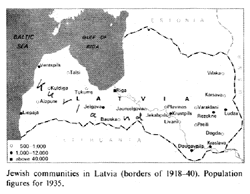
Encyclopaedia Judaica (1971): Latvia, vol. 10, col. 1463, map with Jewish communities in Latvia (borders of 1918-40). Population figures for 1935: over 40,000 Jews: Riga; 1,000-12,000 Jews: Ventspils, Liepaja, Jelgava, Krustpils, Rezekne, Ludza, Daugavpils, and Kraslava; 500-1,000 Jews: Talsi, Kuldiga, Aizpute, Tukums, Bauska, Jaunjelgava, plavinas, Livani, Vilaka, Karsava, Varaklani, Preili, and Dagda.
Bauska
The district town in the Zemgale (formerly Kurland) region, very near to Lithuania, on the bank of the Lielupe river, southern Latvia.
Between 1920-1940 Latvia was independent, and between 1940-1991- part of the Soviet Union.
In the 15th century the Livonian order (an order of Teutonic Knights) built a fort at the place against invasion from Lithuania. The settlement attained the status of a city in 1511. During the years 1561-1795, the city was in the duchy of Kurland, under the protection of Poland, and was annexed by Russia in 1796 after the third partition of Poland. During this period the city developed into a commercial and industrial center.
Already in the 17th century Jews came to Bauska from Lithuania. They were legally permitted to settle in the place after Kurland was annexed by Russia.
At the beginning the Jewish habitation was limited to the suburb of Sloboda across the river. In order to enter Bauska they required a special authorization. In Sloboda they established a synagogue and cemetery, founded a Hevra Kadisha and in 1802 engaged a rabbi.
From 1920, when Jews were allowed to live in Bauska itself, the community began to organize its institutions. Minute books kept by "Hevrat Agadata" and "Hevra Tehilim" were written in Yiddish and Hebrew, and they draw a picture of the Jewish life in the town at that times.
In 1835 there were 2,669 Jews residing in the town and its environs.
The development of the community was temporarily checked by the departure of 692 Jews to agricultural settlements in the Cherson district in 1840, and as the result of a cholera epidemic which struck the town in 1848.
In 1850 the number of Jews in the town and the surrounding area was 2,266.
The first Jewish inhabitants of the town, the "Kurlandim", spoke German and were influenced by western culture. Later arrivals, who came from Lithuania, were observant (upholders of the religious laws) and they spoke Yiddish. The two factions complemented one another and their general and religious education was fostered in parallel.
The community educational institutes included Hamidrash (seminary), the large synagogue, the house of prayers of the Hassidim, the Lithuanian Minyan (a religious quorum), "Tiffereth Bachurim" and a Beth Midrash in Sloboda.
Communal and charity organizations: Hesed, "Bikkur Cholim" (visits to the sick) "Linat Tsedek" (hospice for the poor), "Tsedaka Gedolah", "Malbish Arumim" (clothing for the needy), "Poalei Tsedek" and "Maot Chitim".
The workers, according to their trades, organized prayers and study of the torah on Saturdays.
In 1881 the Jews, who numbered 3,631, comprised 60% of the town`s population. Many came illegally from Lithuania. They were harassed and even expelled from the town; the Jewish population was reduced in number.
The Bauska community was considered to be one of three holy communities in Latvia; many torah sages came from its institutions. Rabbi Mordechai Rabbiner, the founder of a line, which during the course of 150 years produced rabbis, educators and writers who were the leaders of various communities, headed the rabbinical bench of the town from 1802- 1830. Rabbi Mordechai Eliasberg, an appointee of the authorities, labored to resurrect national identity for the Jews. Following him, 1895-1903, the leader of the community was rabbi Abraham Yitzchak HaCohen Kook. Later he became chief rabbi of Eretz Israel.
In 1897 there were 2,745 Jews in the town.
At the beginning of the 20th century a literary-musical society, "Zamir", was founded.
At first the Jewish children learned in two Chadarim, a talmud torah, and secular studies at a Russian school. In 1920 there was a Jewish elementary school which used Yiddish and Hebrew as languages of instruction. In 1926 a Hebrew kindergarten was opened. During this period the talmud torah was open in the afternoons.
In 1915, during World War I, the authorities, for no valid reason, expelled the Jews of Kurland to the depths of Russia. After the war there were only about 600 Jews in the place. They elected a community council which renewed the public life of the Jews.
In 1919, with the return of the government by the Bolsheviks to Latvia, the Jews of Bauska were ordered to perform forced labor by Latvian soldiers.
During the 1920s many Jews moved to Riga and some went on Aliyah to Eretz Israel. Others emigrated to various countries, in particular South Africa.
Many Jews of the town were engaged in commerce, especially in the flax trade. Others made a living as workshop owners, peddlers or carters. There were a number of unemployed who required welfare assistance from the community. Among the Jews there were also landlords and members of the free professions, such as doctors and dentists.
With the help of the "Joint" (a relief organization of American Jewry) a co-operative Jewish bank was established in the town in 1921.
The "Zion" society, which was founded in 1884 by rabbi Eliasberg, opened a library and organized cultural activities. The Zionist youth operated as "Pirhei Zion". Following pogroms against the Jews of Russia in the period 1903-1905, young people of the community organized a self-defense unit. The leader, Israel Friedman, who was accused of producing arms for the defenders, was sentenced to be executed by the authorities.
A son of the town, the lawyer Dr. Lazar Nisselovitch, fought for rights for the Jews, when he was a delegate to the third Duma (parliament) from 1907 to 1912.
During the 1920s anti-Semitic articles began to appear in the local newspapers.
In the mid-twenties the Bund was active in the town, along with several Zionist youth movements.
Four Jews were elected to the municipal council in 1928.
In 1935 there were 778 Jews in the town out of a total population of 4,904.
The Holocaust Period
Following the Ribbentrop-Molotov accord, signed in August 1939 between Germany and the U.S.S.R., Latvia was annexed by the U.S.S.R. in the summer of 1940, when a Soviet government was installed. Businesses owned by Jews were nationalized and community institutions were disbanded. Ten Jewish families, property owners, were sent to detention camps.
After the outbreak of war between Germany and the U.S.S.R. (June 22, 1941), the Jews attempted to escape with the retreating Soviet forces. Among them were 40 young people who were murdered on the border. About a dozen youth, who succeeded in escaping, joined the red army. The majority were killed in action.
On June 26, 1941, German units occupied the town.
On august 3, 50 Jews were shot in a nearby forest. A week later a further 153 Jews were murdered. During this period there were a number of actions in which Jewish men were sterilized. The majority of the Jews were murdered on September 30. They were assembled in a yard and transferred, as was the case with others before them, to the forest. According to another source, about 800 Jews were killed in an "action" (a liquidation operation); this number included Jews from the environs.
The murder of these Jews led to the town being declared "Judenfrei" - cleared of Jews.
On July 30 1944, when Bauska was liberated by the Russians, only two Jews were found in the town. A memorial to the martyrs was erected on the site of the mass murder. Also; https://elirab.wordpress.com/tag/jewish-bauska/
Bauska Phone List 1940
http://www.jewishgen.org/Courland/Bausk_ph.htm
This list is taken from the Latvian Telephone Directory dated April 1940. The names in the directory have been listed in their Latvian form which includes adding an "s" or "is" to male names and an "aa" or "e" to female names. In addition to telephone numbers, the list gives you the name of the telephone subscriber, home address, commercial address where appropriate and sometimes information about businesses and business relationships
For example: The listing under Abrahamsons, Seina provides the further information that in 1940 Sheine Abrahamson practised in partnership as a dentist with B Perlman at Number 18 Pils; drop the final "s" off each name to establish the original name. The diacritical marks over the "S" in Seine indicate that the sound is closer to "Sh" than a pure "s".
Jewish entries: Many Jews had left Bausk by 1938, but you can find the following Jewish names in the list in their Latvian form:
Abrahamson
Perlman
Blauman
Bekman
Berman
Blumberg
Farber
Feitelman
Feitelson
Grinberg
Frishman
Hait
Hercheberg [spelled Hercenbergs]
Israel
Jakobson
Joffe
Kurman
Liebovitz [spelled Liebovic]
Lipman
Nisselovitz [spelled Niselovics]
Perlman
Rozen
Pozmanters [possible]
Sochens
Taube
Thierman
Toik
Woolfson [spelled Vulfson

http://www.jewishgen.org/Latvia/holdingsAtLSHA.html
LATVIAN TIDBITS FROM HISTORICAL JEWISH PRESS
Posted by Ann Rabinowitz in conjunction with the JewishGen Latvia SIG
Continuing with my perusal of the Historical Jewish Press site for Latvian Jewish tidbits, I found the following reported in the Bnai Brith Messenger, Friday, December 18, 1914, regarding the death of Lazar Nisselowitch.
He was born in Bauska, Latvia in 1854 and was known as Lazar or Leopold and he died in Geneva, Switzerland, in 1914, at the age of 60, Lazar Nisselowitch was an important figure in the Jewish community both in his town of Bauska, in Latvia and in Russia itself.
He graduated from the law faculty of the St. Petersburg University in 1880. In the 1880's published several works on law and finance and was associated with the Russian Ministry of Finance. He was a lawyer and editor of the weekly newspaper Nediela.
He became a member of the First Russian Duma and was also in the Second Duma and the Third Duma representing Courland and the Cadet Party where he rose to the position of the chief spokesman for the Jews of Russia.
He was known for his proposal on May 31, 1910, with fellow deputy N. Friedman and the help of the Constitutional-Democratic Party to abolish the Pale of Settlement. He received 166 votes from his fellow deputies in the Duma and then the question went no further until after the February, 1917 Revolution when the Provisional government abolished the Pale.
He was a very much a respected and beloved figure and one that that has been mostly forgotten in historical accounts and particularly English sources..
